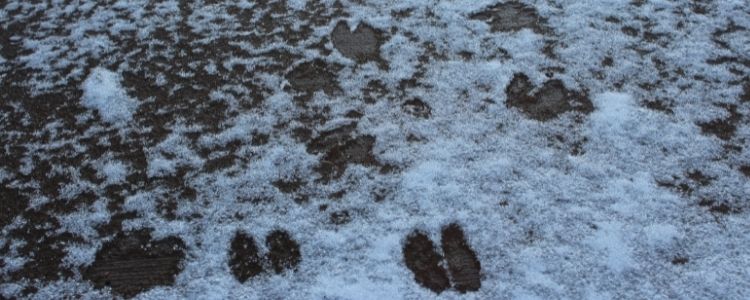Think about all the places you go during the week – to school, to the store, to the park – all of these places are important to you. In fact, every animal species needs a certain amount of space to survive and be successful, and animals are moving around for a variety of reasons all the time. They move for food, shelter, and to escape predators. All animals move around on a daily basis. The main area an animal uses to meet its daily needs is called its habitat. Exploring winter habitats can lead to wonder and excitement about the natural world. It’s kind of a fun mystery to solve… figuring out where an animal came from or where it was going and imagining what it might have been doing. Looking carefully at an animal track, you can learn a great deal about the critter’s activities and routines. Follow the tracks and a story is revealed!
A host of clues reveal the activities of wildlife all around us in the winter. Pick a day right after a snowfall and see how many different types of tracks you can find. Here are some hints for your next animal track treasure hunt!
- It’s very common to find squirrels, birds, and maybe rabbit tracks if you’re looking in your own backyard.
- Four toes on each of the front and hind feet indicate the track was left by a member of the dog or cat family – a fox, wolf, coyote, bobcat, lynx, or neighborhood dog or cat.
- Four toes on the front feet with five toes on the hind feet indicate the track was left by a rodent – mouse, vole, chipmunk, squirrel, woodchuck, muskrat, or even a porcupine.
- Tracks that have five toes each on the front and hind feet indicate it’s from a raccoon or a member of the weasel family – weasel, badger, mink, skunk, otter. It could also mean a bear, beaver, or opossum.
- If you find a two-toe track on a trail in Wisconsin, it is likely a deer. Moose and elk also leave two-toe tracks, but they are relatively rare in Wisconsin.
So get out and make your own tracks! Create your own story! Get the kids unplugged, off the couch, and out on the trail. That itself is no small feat (pun intended), but just getting the kids out and noticing the tracks, not even necessarily identifying the animals that made the tracks, can inspire wonder and delight.
While exploring animal tracks, give the Wisconsin DNR Tricky Tracks Quiz for Beginners a try. Good luck & get tracking!

